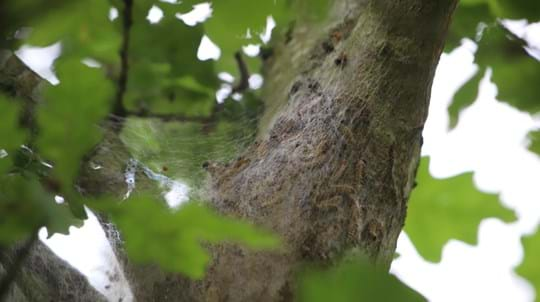
Pests and diseases
What are we looking out for?
The pests and diseases we are most keen to hear about.

Forest Research
In the early 1900’s, the large, rather conspicuous gypsy moth was lost from the British list of breeding insects. A specialist feeding on bog-myrtle and creeping willow, it became extinct when the fens of Cambridgeshire and Norfolk were drained. However, 90 years later the gypsy moth was back when the European race was found breeding in a small area of northeast London. Though now widespread throughout much of London, the moth is found patchily throughout a wide area southeast from an imaginary line through Bournemouth, Reading and Luton, and finally to Southend-on-Sea. Despite being large and colourful, gypsy moth larvae can be surprisingly hard to find, and as such we are almost certainly under recording this species and so we are now looking for your help to better understand its distribution.
The European race is somewhat different to the original British form, being slightly smaller, but considerably more voracious, feeding on over 300 different plant species (known as being ‘polyphagous’). The European gypsy moth can occasionally reach outbreak numbers in continental Europe, causing considerable damage to trees and shrubs before the population crashes again. Being able to feed on so many different plants is key to the way that gypsy moths disperse and exploit new habitats, as unlike in many moths it’s not the adults that are the primary dispersers, but the larvae. But how do such small caterpillars disperse long distances? Well, they happen to be expert balloonists.
Once they hatch in early May from a large, scruffy egg mass, the tiny caterpillars crawl as high as they can, and hang down from a branch on a silk thread until the wind catches them and sends them on their way. Though most ballooning events end fairly abruptly, occasionally one gets blown rather a considerable distance, and it’s here that being able to feed on so many plants comes in handy. The caterpillar grows quickly, and as it does so it begins to slightly change its behaviour, becoming largely nocturnal, and returning to shelters on the ground during the day to rest. It’s at this time in late May to July, when the larvae are over 30mm long and covered in a characteristic pattern of paired warty nodules (or ‘tubercles’), five blue and six red, and are beginning to eat whole leaves at once, that they are most often encountered in the garden. Large female caterpillars can reach 65mm in length by August, whereupon they stop feeding, and begin wandering trying to find a safe place to pupate, eventually emerging in late-July through to early-September as adults.
Once emerged and ready to go, female gypsy moths find a suitable tree trunk, fence post, house wall, or any other flat surface, and begin to release a mating pheromone, which attracts males toward her from miles around. This is one of the reasons the species is such a successful colonist – a single female, dispersed as a larva a considerable distance from other gypsy moths, can still successfully attract a mate to start the next generation.
Being a rapidly dispersing, polyphagous species, it’s no surprise that in Europe the species can occasionally outbreak causing mass defoliation across trees and gardens. Though most tree species can bounce back from a single defoliation, some, particularly evergreen species, can’t do this. After being accidentally introduced to the United States in the 1860’s, gypsy moth has slowly spread throughout the northeast of the country, occasionally building up large localised populations and causing considerable damage. In Britain however we seem to be luckier as, though the moth is well established here, it has never reached outbreak proportions.
With a changing climate, gypsy moth is more than likely to become widespread across southern Britain. Knowing if outbreaks are likely to happen in the UK requires knowledge as to where the moth is distributed so we can better predict areas where preventative action may be required to stop the species causing widespread damage.
This is where you can help us. Though there is no statutory requirement to do so, if you find gypsy moth caterpillars or egg masses in Britain, outside of London, please report them to us through Tree Alert, the Forestry Commission’s online reporting tool. We would be particularly interested in any sightings of caterpillars causing defoliation or where large numbers of caterpillars are seen at the same time.